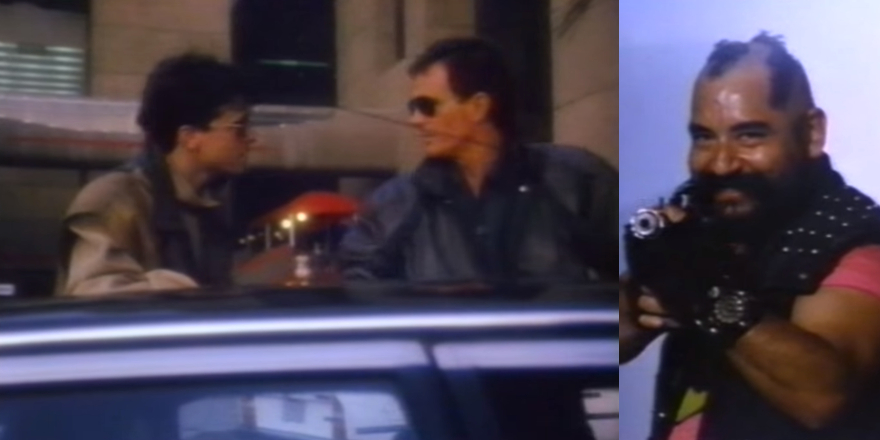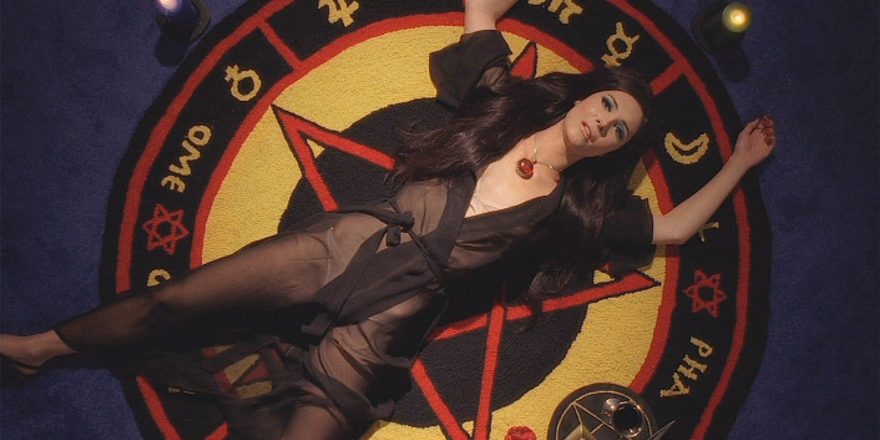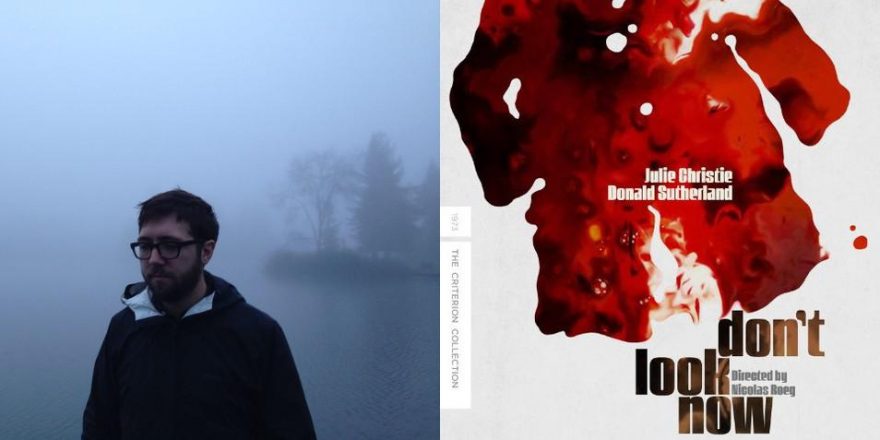For anyone who had ever considered film editing as a career, there was no better place to be in the late ’80s and early ’90s than Roger Corman’s company, Concorde-New Horizons. The home-video market had exploded and the world was searching for content. Roger, always the savvy businessman, was in a prime position to capitalize on this media hunger. His goal was to produce 12 to 15 low-budget movies per year. Love stories, kids movies, action movies, comedies. Most of them were made at his studio (an abandoned lumber mill) in Venice, California, but every year a few were produced in other countries, such as Peru and the Philippines.
My first solo feature editing credit was on a film called Not of This Earth, a remake of a film Roger had directed in 1957 about an alien-vampire who comes to Earth to steal our blood in order to save his dying planet. Jim Wynorski directed the update and it starred Traci Lords in her first legitimate non-pornography role. I couldn’t believe I got the job and was absolutely thrilled to be editing my first movie. Jim had only 10 days to shoot and when I put the footage together, the film was extremely short, even by Roger’s standards. In a desperate attempt to pad the running time, Jim suggested we steal a scene from Humanoids From the Deep, another Corman movie made a couple of years earlier. I couldn’t believe what I heard. Steal a scene? How? We can do that? Jim confidently confirmed that we could. Not only did I find this idea completely exhilarating, but also hilarious and outrageous. “Now this is editing,” I thought!
The stolen scene consisted of a woman, wearing a skimpy red teddy (of course), brushing her hair alone in her bathroom. A noise outside her window startles her. Suspense builds as she sneaks slowly from room to room, investigating. There are starts and scares along the way, a shirt falls off a hanger, making a very loud sound. She accidentally (and loudly) knocks some dishes into a sink. A phone rings (loudly) and she jumps. Eventually she picks up a large kitchen fork and makes her way to the rattling front door. We used the whole scene, except at the very end inserted a shot of our actress holding up a fork and giving a blood-curdling scream. She kind of matched the actress from the original scene. Kind of. … Well, they were both blonde, at least. Anyway, she was then quickly zapped by our villain’s X-ray eyes. It was all so quick and basically worked, and we added three minutes to the film! I was hooked on stealing scenes.
This practice reached its near-pinnacle when I was hired to edit Hollywood Boulevard II, a remake of another Roger film from a few years earlier called, surprisingly, HollywoodBoulevard. Allan Arkush and Joe Dante were the directors of the original and true leaders in the concept of “recycling” footage. In fact, they had created their entire movie out of stolen scenes from other Roger films. We were proudly following in their footsteps. With the script in hand, my first task was to comb through Roger’s library and find scenes of jungle battles, car crashes, helicopter explosions and anything else we could use. In all seriousness, why shoot a car chase when there were already two or three perfectly good ones in Roger’s library? All we had to do was shoot a few angles of our actresses turning a steering wheel from side to side, cut it into our stolen car chase and, voila! It’s still beyond me why Hollywood’s major studios haven’t started a recycling program.
All of which leads me to Welcome to Oblivion aka Ultra Warrior. I had been minding my own business when I got a call from Mike Elliott, the guy running Roger’s studio at the time, who expressed concern about a movie they had just shot in Peru. It was in trouble and in need of a recut. After taking a look at the movie, a post-apocalyptic sci-fi action adventure film, I met with Mike. It was obvious what was wrong with the movie, so I just said it: “It needs a space war.” Mike agreed, and I was hired on the spot. Because of my previous experiences on Hollywood Boulevard II, Not of This Earth and other Concorde-New Horizons films, I had become something of an in-house expert on Roger’s library. If another editor or film needed, say, a boat explosion, or a woman with three breasts dancing, I could usually point them in the right direction.
When I was hired to work on Ultra Warrior, it unfortunately lacked any kind of action or adventure. It also lacked a story, was generally incoherent, badly shot and too short. Although its star Dack Rambo was likable, much of the rest of the cast (hired locally in Peru) didn’t speak English. The consensus for those who had seen the film was that it was beyond redemption. So, with nothing to lose, Mike let me loose in the cutting room with a couple of 3/4-inch editing decks.
For starters, I thought the film needed a prologue. It would not only add to the skimpy running time, it would also inform us how this place called Oblivion earned its name. So with an atom bomb explosion stolen from (I think) The Devastator and some voiceover I wrote for my assistant editor to read, we set up the world of Oblivion. Classic post-apocalyptic stuff. You know … a nuclear catastrophe, survivors descend into chaos and ruin. No food. No water. Peace-loving tribes constantly chased by roving bands of murders and hoodlums. That kind of thing. Roger had a number of post-apocalyptic movies to steal from, such as Future Kick and Space Raiders. What surprised me most, however, was how easily footage from middle-earth fantasy films like Death Stalker II and Barbarian Queen cut so perfectly with the post-apocalyptic footage. It truly worked like magic – as you can see below!
There was a loose storyline in the movie in which Dack Rambo’s character, Kenner, had to go into the “radioactive wasteland” in search of a mineral called Zirconium. After the aforementioned prologue, we meet Kenner waiting in a quiet bar for his mission. “This is no way to introduce our lead character!” I thought. I remembered a bar scene from either Saigon Commandos or Heroes Stand Alone (two Rambo knock-offs shot in the Philippines) which featured a band with a female singer doing a rockin’ version of “House of the Rising Sun.” “How thematically perfect!” I thought! I cut that footage into the scene, and to spice it up even more I added some pole dancers from Stripped to Kill II: Live Girls and Dance of the Damned. Now it seemed like he was waiting in a strip bar, listening to a kickass band!
After Kenner gets his marching orders from his “corporate” boss, he’s forced to take on a kid partner named Phil, who was played by a local Peruvian actor named Diego Bertie. A classic reckless sidekick who you know is going to get killed in the first 30 minutes. As Kenner and Phil make their way into Oblivion, the thought came to me that maybe all the main characters could have flashbacks. By using stolen footage and carefully written voiceover, we could not only get to know our characters but also add some production value to some of the scenes that were really hurting. I knew the Film Gods agreed, as they lead me to a submarine movie called Full Fathom Five, also shot in Peru and co-starring none other than Diego Bertie – a cinematic miracle! So now Phil (Diego) could have a flashback to himself in a submarine movie. The only slight setback was that Full Fathom Five was more or less a knock-off of The Hunt for Red October and didn’t really look like a science-fiction picture, but the Film Gods happily pointed me to Lords of the Deep, a knock-off of The Abyss which had fantastic visual effects and a huge underwater earthquake. All we needed now was a little on-the-nose voiceover from Phil, talking about how he used to take his submarine into the underwater mines and how he fondly remembers it as the best summer job he ever had.
Once Phil has been killed (within the first 30 minutes), Kenner meets Grace in Oblivion. Though part of a deformed mutant species ironically called “the Muties,” Grace is attractive and looks fine. She is your classic no-nonsense, tough-as-nails rebel leader. Obviously it’s only a matter of time before they become lovers. Broken-hearted by Phil’s death, Kenner tells Grace why he’s come to Oblivion. With some futuristic footage from Crime Zone and some space wars from Battle Beyond the Stars, Kenner explains with new voiceover how the outside world desperately needs Zirconium. In a revealing moment, he lets her know he has no family and asks about hers. Using new voiceover and footage from Dune Warriors and Equalizer 2000 (both Mad Max knock-offs), Grace tells Kenner the heartbreaking story of how her parents were murdered by a subterranean mutant sect. Now knowing they are both alone in the world, their hearts soften and they begin to warm to each other.
The nonstop action (or lack thereof) continues as Kenner and Grace are captured and enslaved by an evil warlord known as the Bishop. Kenner helps Grace and other mutant slaves escape and is ultimately accepted by them as one of their own. He is even invited to meet their spiritual leader, Uncle Lazarus. This was a problematic scene, however, as Uncle Lazarus looked like he was photographed in a dunking booth at a carnival. Not to mention that the crowd of mutants swayed and worshipped him even though he wasn’t saying anything. I wondered, what would he say if he could speak? Maybe as a metaphor, he would talk about the great white wolf that once roamed their land before the wars and destruction? Fortunately, there was such footage! Roger had produced A Cry in the Wild, a beautifully shot family film about a boy who survives in the wilderness after a plane crash. It had amazing wolf shots and when mixed with Uncle Lazarus’ newly written voiceover and intercut with action footage from Battletruck, the entire history, hopes and dreams of the Muties could be presented. (A funny side note: Mark Griffiths, the director of A Cry in the Wild, once claimed he had made the only Corman movie that could never be used for stock footage.)
A lot of things happen and a lot of things don’t in Ultra Warrior. Kenner becomes an unlikely hero, saving the Muties and Oblivion. He and Grace get together and in a final poignant moment he decides to stay in Oblivion with Grace (even though it’s radioactive). They drive off back into Oblivion to live happily ever after.
I don’t remember how many films I borrowed footage from … maybe 25? It was a lot. And for all my hard work and sins against cinema, I was awarded a co-directing credit. Was Ultra Warrior still a lost cause? You bet it was. But that didn’t matter to me because working on it was … the best summer job I ever had.








